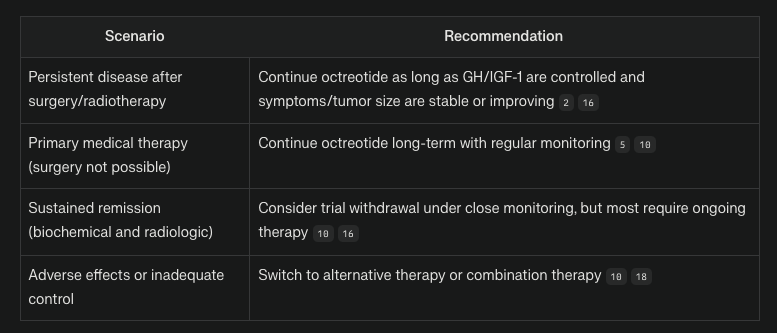## Duration of Octreotide Therapy in Acromegaly
How long to give Octreotide in a patient with Acromegaly
Research by : Perplexity
Edited by: Dr. Om J Lakhani

Duration of Octreotide Therapy in Acromegaly
Overview
Octreotide, a somatostatin analog, is a cornerstone in the medical management of acromegaly, particularly for patients with persistent disease after surgery or those unsuitable for surgery. The duration of octreotide therapy is not fixed and is individualized based on biochemical response, tumor control, symptom relief, and the presence of adverse effects.
Key Principles Guiding Duration
-
Indefinite Treatment: Octreotide is generally continued long-term—as long as it is effective in controlling growth hormone (GH) and insulin-like growth factor-1 (IGF-1) levels, reducing tumor size, and improving symptoms[1][2][3].
-
Regular Monitoring: Therapy duration is guided by regular assessment of biochemical markers (GH and IGF-1), MRI for tumor size, and clinical symptoms. Dose adjustments are made based on these parameters[4][5].
-
Discontinuation or Switch: Treatment may be discontinued or switched if:
- Biochemical control (normal IGF-1 and GH <1 μg/L) is achieved and sustained, and there is no residual tumor.
- The patient develops significant adverse effects.
- There is inadequate biochemical control despite maximal dosing, prompting a switch to another therapy (e.g., pasireotide, pegvisomant, or combination therapy)[6].
Evidence from Clinical Studies
-
Long-Term Efficacy: Studies report mean durations of octreotide therapy ranging from 24 months (2 years) up to more than 16 years in well-controlled patients[1:1][2:1][3:1].
-
No Tachyphylaxis: Long-term use does not typically lead to loss of efficacy (tachyphylaxis), and many patients remain well-controlled for years[1:2][3:2].
-
Dose Titration: Dosing is typically titrated every 3–6 months, and dose can be reduced if sustained biochemical control is achieved[4:1][5:1].
Practical Recommendations

Special Considerations
-
Annual Breaks: In patients who have received radiation therapy, some protocols suggest periodic breaks from octreotide (e.g., 4 weeks off immediate-release or 8 weeks off long-acting per year), though this is not standard for all patients and should be individualized.
-
Gallbladder Monitoring: Long-term therapy increases risk of gallstones; regular ultrasound monitoring is recommended[7].
Summary Table: Duration of Octreotide in Acromegaly

Conclusion
Octreotide therapy in acromegaly is typically continued long-term, often for many years, as long as there is ongoing clinical and biochemical benefit, and the patient tolerates the medication. Regular monitoring is essential to guide dose adjustments and evaluate the need for continued therapy or a switch to alternative treatments[1:3][4:2][6:1][3:3][5:2].